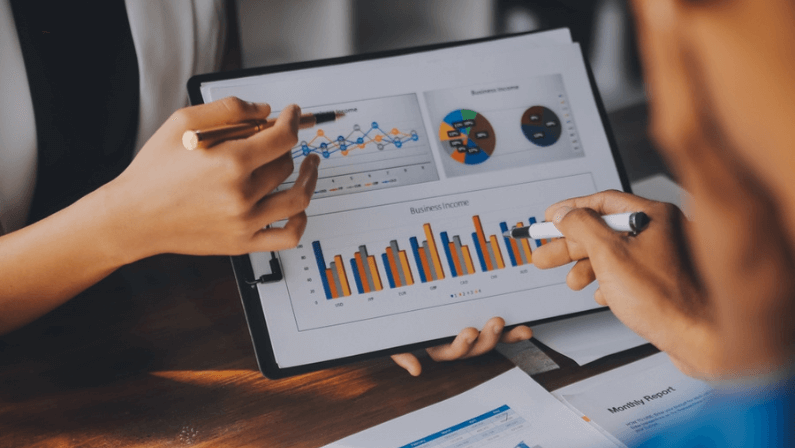Mastering sales forecasting is more than a strategic advantage—it’s a foundation of sustainable success.
Businesses can proactively plan, optimize resources, and stay agile in dynamic market conditions by accurately predicting future sales trends and consumer behavior.
Here’s how you can understand the profound benefits of sales forecasting, which empowers organizations to keep up and lead in their industries.
What is sales forecasting?
Sales forecasting involves predicting future sales levels and trends based on historical data, market analysis, and other relevant factors. It helps businesses anticipate demand, manage resources effectively, and make informed strategic decisions to achieve growth and profitability.
How is Sales Forecasting Different from Demand Planning?

While sales forecasting predicts future sales based on historical data and market trends, demand planning focuses on managing inventory and supply chain activities to meet forecasted demand effectively.
- Focus: Sales forecasting primarily predicts customer demand and sales trends, while demand planning focuses on operational activities to meet that demand.
- Time Horizon: Sales forecasting looks further into the future to predict sales volumes, whereas demand planning focuses on shorter-term inventory management.
- Scope: Sales forecasting considers broader market factors and customer behavior, whereas demand planning is more operational, dealing with logistics and inventory levels.
Why is Sales Forecasting Important?
Sales forecasting is crucial for businesses to make informed decisions and stay competitive.
- Strategic Planning: Helps businesses set realistic goals and develop strategies to achieve them.
- Resource Allocation: Enables effective allocation of resources such as inventory, manpower, and marketing budget.
- Financial Planning: Facilitates financial planning and budgeting based on projected sales.
- Risk Management: Allows businesses to anticipate market changes and mitigate risks proactively.
What a Business Needs to Prepare for Accurate Sales Forecasting

To ensure accurate sales forecasting, businesses should follow these essential steps:
- Historical Data: Gather and analyze past sales data to identify trends and patterns.
- Market Analysis: Conduct thorough market research to understand customer behavior, competition, and economic factors.
- Sales Team Input: Collaborate with the sales team to gain insights into customer feedback and market conditions.
- Forecasting Tools: Utilize reliable forecasting tools and software to process data and generate forecasts.
- Regular Review: Continuously review and adjust forecasts based on real-time data and market changes to maintain accuracy.
Keys to success in sales forecasting
Achieving effective sales forecasting involves employing strategic approaches that leverage technology, regular updates, and comprehensive consideration of factors impacting your business environment.
Use Technology like AI
Integrating advanced technologies such as Artificial Intelligence (AI) enhances the accuracy and reliability of sales forecasts. AI can analyze vast amounts of data quickly, identify patterns, and generate insights that improve forecasting precision. By harnessing AI capabilities, businesses can adapt swiftly to market changes and make data-driven decisions with confidence.
Review and Update Forecasts Regularly
Regularly reviewing and updating forecasts is essential to maintaining relevance and accuracy. Markets evolve, consumer behavior shifts and external factors fluctuate, impacting sales projections. By continually reassessing forecasts based on real-time data and market insights, businesses can stay agile and proactive in adjusting strategies to meet changing demands and conditions.
Account for Internal and External Factors
Effective sales forecasting considers a range of internal and external factors that influence business performance. Internal factors may include sales team performance, marketing initiatives, and production capabilities, while external factors encompass economic trends, competitor activities, and regulatory changes. By thoroughly analyzing these variables, businesses can develop more robust forecasts that account for potential risks and opportunities, enabling strategic decision-making and sustainable growth.
Common Sales Forecasting Challenges

Navigating sales forecasting comes with several challenges that businesses must address to ensure accuracy and reliability in predicting future sales trends.
Lack of Sales History
One of the primary challenges in sales forecasting is the absence of sufficient historical data. New businesses or products may lack past sales records, making it difficult to establish reliable patterns and trends. Overcoming this challenge requires leveraging alternative data sources, or industry benchmarks to inform projections accurately.
Inaccurate Data
Inaccuracies in data collection or analysis can lead to flawed forecasts. Whether due to human error, outdated information, or incomplete data sets, inaccurate data undermines the reliability of sales predictions. Implementing robust data validation processes and utilizing advanced analytics tools can help mitigate this challenge, ensuring data integrity and enhancing forecast accuracy.
Lack of Collaboration
Effective sales forecasting relies on collaboration across departments, including sales, marketing, finance, and operations. A lack of communication and collaboration between these teams can result in siloed information and conflicting forecasts. Establishing cross-functional collaboration and implementing regular meetings to align on goals and insights fosters a unified approach to forecasting and improves overall accuracy.
Seller Subjectivity
Sales forecasts can be influenced by individual biases or overly optimistic projections from sales teams. This subjectivity can lead to overestimating potential sales or disregarding critical market indicators. Mitigating seller subjectivity involves implementing standardized forecasting methods, conducting objective performance reviews, and leveraging data-driven insights to temper personal biases.
Technology Limitations
While technology enhances forecasting capabilities, limitations in software capabilities or inadequate data integration can hinder accuracy. Outdated systems, lack of user training, or insufficient customization of forecasting tools may limit the ability to generate precise predictions. Investing in modern forecasting technologies, conducting regular software updates, and providing training to users can optimize technology’s potential in overcoming forecasting challenges.
Company forecasts across the enterprise
In a business context, forecasting extends beyond sales to encompass various facets of organizational operations, each playing a critical role in strategic planning and decision-making.
Sales
Sales forecasting predicts future sales volumes, trends, and revenue generation based on historical data, market analysis, and sales pipeline metrics. It helps sales teams anticipate customer demand, set achievable targets, and allocate resources effectively to drive revenue growth.
Finance
Financial forecasting involves projecting future financial performance, cash flow, and budget requirements. It enables finance teams to plan investments, manage expenses, and ensure financial stability by predicting revenue streams, expenses, and financial risks.
Marketing
Marketing forecasting anticipates market trends, consumer behavior, and campaign outcomes to optimize marketing strategies. It guides marketing teams in budget allocation, campaign planning, and resource allocation to maximize ROI and achieve marketing objectives.
Supply Chain
Supply chain forecasting predicts demand for products or services, inventory requirements, and supply chain logistics. It aids supply chain management in optimizing inventory levels, minimizing stockouts, and ensuring timely delivery to meet customer demand while reducing costs and improving efficiency.
HR
HR forecasting forecasts workforce needs, labor trends, and staffing requirements to align human resources with organizational goals. It assists HR departments in workforce planning, talent acquisition, succession planning, and development strategies to maintain a skilled and motivated workforce.
IT
IT forecasting forecasts technological needs, infrastructure requirements, and IT investments to support business operations and strategic initiatives. It helps IT departments plan for hardware, software, cybersecurity measures, and technological upgrades to enhance operational efficiency and maintain competitive advantage.
Factors That Can Impact Your Sales Forecast
Various external and internal factors can significantly influence the accuracy and reliability of your sales forecast, requiring careful consideration and adaptation in forecasting strategies.
Hires and Fires
Changes in staffing levels, including new hires or layoffs, can directly impact sales productivity and customer relationships, affecting forecasted sales volumes.
Policy Changes
Changes in government policies, regulations, or industry standards can alter market dynamics, consumer behavior, and operational costs, influencing sales forecasts.
Territory Shifts
Changes in sales territories, expansions into new markets, or shifts in customer demographics can impact sales forecasts by altering demand patterns and market penetration strategies.
Competitive Changes
Competitors’ actions, such as pricing strategies, product launches, or market expansions, can shift market dynamics and affect your sales forecast.
Market Changes
Fluctuations in market demand, trends, or customer preferences can lead to variations in sales forecasts, necessitating adaptive strategies to align with evolving market conditions.
Economic Conditions
Changes in economic factors like inflation rates, interest rates, or consumer confidence levels can impact purchasing power and consumer spending habits, influencing sales forecasts.
Legislative Changes
New laws, regulations, or taxes can affect business operations, production costs, and consumer behavior, potentially altering sales forecasts and profitability.
Product Changes
Introducing new products, discontinuing existing ones, or making significant updates can impact sales forecasts by influencing customer demand and market acceptance.
Seasonality
Seasonal fluctuations in demand, such as peak sales periods or seasonal downturns, must be factored into sales forecasts to accurately predict revenue streams and resource requirements.
How to accurately forecast sales
Developing accurate sales forecasts is essential for strategic planning and business growth. It requires a systematic approach that integrates historical data, market insights, and proactive monitoring of industry trends.
Assess Historical Trends
Reviewing past sales performance and trends provides valuable insights into seasonal patterns, growth trends, and cyclical fluctuations, forming a foundation for projecting future sales expectations based on historical data.
Incorporate Changes
Adapt sales forecasts to incorporate changes in market conditions, consumer behavior, and internal factors such as product launches, pricing adjustments, or operational enhancements that may impact sales projections.
Anticipate Market Trends
Stay informed about emerging market trends, shifts in consumer preferences, technological advancements, and economic indicators that could influence future sales outcomes. Anticipating these trends allows businesses to adjust forecasts accordingly and capitalize on opportunities.
Monitor Competitors
Monitor competitor activities regularly, including pricing strategies, marketing campaigns, and product innovations, to assess competitive dynamics and their potential impact on market share and sales forecasts.
Include Business Plans
Align sales forecasts with overarching business plans, strategic initiatives, and operational goals to ensure coherence and synergy across departments. Integrating sales forecasts into broader business planning enhances alignment and supports informed decision-making.
Sales Forecasting Methods
Effective sales forecasting employs diverse methods tailored to specific business needs and market conditions, each offering unique insights into future sales performance.
1. Opportunity Stage Forecasting Method
This method predicts sales based on the progression of opportunities through various stages in the sales pipeline, providing visibility into potential revenue based on the likelihood of closing deals at each stage.
2. Length of Sales Cycle Forecasting Method
Forecasting sales by analyzing the average duration of sales cycles helps businesses anticipate when deals will close, enabling accurate prediction of future revenue based on historical data and current pipeline activity.
3. Intuitive Forecasting Method
Intuitive forecasting relies on the expertise and judgment of experienced sales professionals to estimate future sales based on market knowledge, customer relationships, and qualitative assessments of potential opportunities.
4. Historical Forecasting Method
Historical forecasting involves using past sales data to identify trends, patterns, and seasonal fluctuations, providing a basis for projecting future sales volumes and revenue based on historical performance.
5. Multivariable Analysis Forecasting Method
Multivariable analysis combines multiple factors such as market trends, economic indicators, customer demographics, and competitive dynamics to develop comprehensive sales forecasts, integrating quantitative and qualitative data for enhanced accuracy.
6. Test-Market Analysis Forecasting Method
This method involves conducting controlled test markets or pilot studies to gauge customer response and demand for new products or services. It provides empirical data to forecast sales performance when launching in broader markets.
Features to look for in sales forecasting software
When selecting sales forecasting software, prioritize solutions that offer robust features to enhance accuracy, efficiency, and strategic decision-making.
- Advanced Analytics: Look for software that integrates advanced analytics capabilities to analyze historical data, identify trends, and generate accurate forecasts.
- Customization: Choose software that allows you to customize forecasting models and parameters to align with your business’s unique needs and industry dynamics.
- Integration: Opt for software that seamlessly integrates with your existing CRM, ERP, and other business systems to streamline data flow and ensure platform consistency.
- Collaboration Tools: Select software with collaborative features that enable team members from sales, marketing, finance, and operations to contribute insights and collaborate effectively on forecasting efforts.
Why Leapify CRM is the Best CRM for E-commerce
Leapify CRM stands out as the best CRM solution for e-commerce businesses, offering robust features tailored to enhance sales forecasting, customer relationship management, and business growth.
With our advanced analytics, seamless integration, user-friendly interface, and fair pricing
Leapify CRM empowers businesses to streamline operations, optimize sales strategies, and achieve sustainable success in the competitive e-commerce landscape.
Schedule a consultation with our experts today to discover how Leapify CRM can elevate your e-commerce operations and drive profitability.


